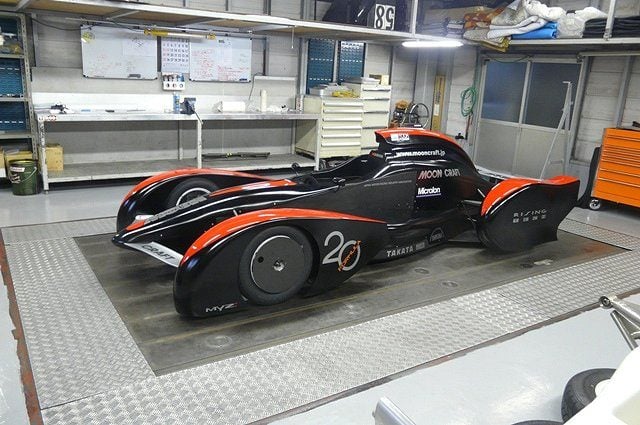"Collectively, racers are a doubting breed, always skeptical of something new and usually wary to try it. It’s always been that way, whether it’s a car, engine, driver or rules change.
The proposed Delta Wing concept Indy car for 2012, which will be displayed to the public for the first time at an upcoming auto show, has enthused most of the 50 or so people who have seen the model and listened to designer Ben Bowlby’s presentation.
However, some doubters claim it will be unstable or not even turn the corners, while the car owners behind the project love its space-aged shape and are convinced it will be much racier compared to today’s aero sensitive cars.
The naysayers scoff at 325 horsepower and a chassis that’s going to weigh significantly less than a sprint car while the Delta Wing LLC. group is jazzed about the in-line 4 turbo engine’s sound, mileage and identity with the American car manufacturer.
An open wheel purist will likely have difficulty embracing the radical look at first but that was the same reaction the roadster devotees felt when the rear-engine revolution broke out.
But, the bottom line is that IndyCar is long overdue for a makeover because running the same car for seven seasons has made things boring, predictable and did I mention boring?
That ugly old Dallara has sucked the life out of a Gasoline Alley that once enjoyed cutting edge technology and embraced free thinking.
What Brian Barnhart & Company can’t seem to grasp is that the different cars and engines were always as big a part of the attraction to Indianapolis as the drivers.
We idolized Jim Hurtubise, Jim Clark and Parnelli Jones and we paid even more attention when they were in the Novi, the Lotus and the turbine. Roger Penske tried three chassis in 1995 and still couldn’t make the show a year after dominating Indy and there’s never been a bigger crowd on Bump Day.
Open wheel racing, even in the late ‘90s in CART, boasted five chassis and four engine manufacturers, which created interest, competition and a cash flow that hasn’t been seen since.
Nobody is saying that a new car/engine package is immediately going to add 25,000 spectators to the ISC ovals or manufacturers are going to start throwing money at IndyCar teams.
But what if an American-built car only cost half of what owners have to shell out today? What if the car was assembled in Indianapolis from components built over here instead of paying the outrageous exchange rate to get parts from Italy? What if the rules were written so that local race car builders like Joe Devin and Danny Drinan could come compete at Indy with their own ideas and not have it cost them $1 million for one month?
What if the trailing car suffered no aerodynamic disadvantage going into a corner?
What if Lola, Swift and Panoz are enticed to come back?
What if the engine cost a tenth of what a lease is today? What if it got such great mileage that rebuilds were 5,000 miles apart? What if the smaller, more efficient engine platform suddenly got Detroit’s interest? What if Porsche or Audi or Alfa wants to show off their 4-cylinder engines?
What if normally-aspirated or V-6 engines also wanted to play?
What if suddenly
there were 50 cars going for 33 spots in May instead of scrambling at the last minute to fill the field?
We won’t know the answers to these questions for at least a year but the point is that at least the owners are taking the initiative to try and come up with something fresh, different and relevant to the times.
As well as something more affordable.
Of course the most interesting aspect of this move is that Bowlby is employed by Ganassi and the Chipster has spent his own money fronting this project.
Considering Ganassi and Penske and their four drivers (Dixon, Franchitti, Briscoe and Castroneves) won 16 out of 17 races in 2009 and those two operations have been in victory lane 48 of the last 65 races dating back to 2006, one would imagine they’d be content to keep the same car for another eight years.
Yet as much as Ganassi enjoys winning, he seems to realize this stagnant formula isn’t a good scenario on many fronts.
Why would we think a new car might loosen the stranglehold Ganassi and Penske have on the field? Just look at Champ Car in 2007 and note that the little teams of Derrick Walker and Keith Wiggins each scored a pair of wins in the new Panoz DP-01. Sure, Newman/Haas/Lanigan still won the most races and the title with Sebastien Bourdais but that new car truly leveled the playing field.
There’s no denying that Honda and Dallara have been good suppliers and, without Honda, this series may have already died. Nobody is saying they’re not welcome, but having a closed shop for spec racing is not what IndyCar is about, nor what it needs. Honda’s attitude was always the more the merrier and that’s what IndyCar’s attitude needs to be.
But even though IndyCar has given a verbal OK to the Delta Wing Project to create a prototype, there’s hardly been a show of support. The Hulman/George family should welcome it because it won’t cost them anything and could actually instill some renewed interest in Indy.
Barnhart will be the biggest obstacle either because he feels threatened or ostracized but, considering his total lack of effort in addressing new cars, budgets or rules, he seems to be part of the problem instead of the solution.
The last thing IndyCar needs is another war but don’t be surprised if one breaks out over this new car. "








